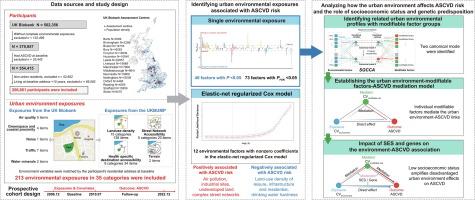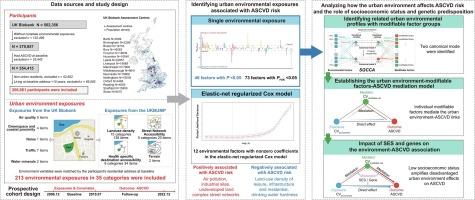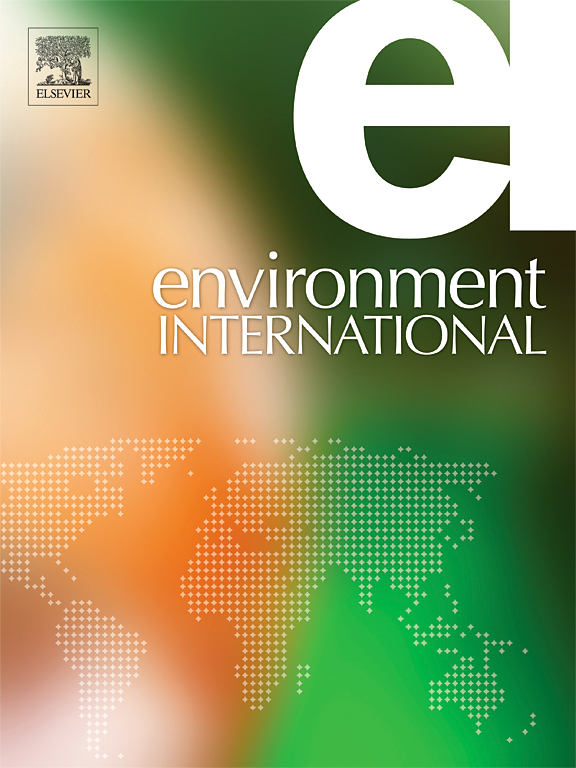城市环境与动脉粥样硬化性心血管疾病的关系:英国生物库前瞻性队列研究
IF 10.3
1区 环境科学与生态学
Q1 ENVIRONMENTAL SCIENCES
引用次数: 0
摘要
城市环境与心血管健康密切相关,但目前仅对少数几种特定暴露进行了单独研究,且大多采用横断面设计。社会经济地位和遗传易感性的影响也仍不清楚。因此,我们利用英国生物库数据(n = 206,681),对 213 个城市环境变量及其与动脉粥样硬化性心血管疾病(ASCVD)的关系进行了前瞻性分析。ExWAS 和正则化 Cox 模型分析强调,空气污染、工业用地和复杂的街道网络是主要的环境风险因素。相反,休闲、公共服务、基础设施和住宅的土地使用密度以及饮用水硬度与 ASCVD 风险呈负相关。通过整合稀疏典型相关性分析和中介分析,我们发现不同的城市环境模式通过不同的途径影响着心血管疾病。以污染和复杂街道为特征的环境通过不利的心理健康影响心血管疾病(中介比例:30.7%,95% CI:22.4%-44.0%),而高度发达的社区和高水质环境则通过心脏代谢状况影响心血管疾病(22.6%,95% CI:19.7%-26.0%)。此外,我们还发现低社会经济地位会放大不利的城市环境对 ASCVD 的影响,但在 ASCVD 遗传易感性方面却没有类似的发现。这项研究加深了我们对城市与心血管健康之间的联系以及社会经济地位的作用的理解,对城市规划和公共卫生干预具有重要意义。本文章由计算机程序翻译,如有差异,请以英文原文为准。


Association of urban environments with Atherosclerotic cardiovascular disease: A prospective cohort study in the UK Biobank
Urban environments and cardiovascular health are closely linked, yet only a few specific exposures have been explored in isolation and mostly adopting cross-sectional design. The influence of socioeconomic status and genetic predisposition also remains unclear. Hence, leveraging the UK Biobank data (n = 206,681), we conducted a prospective analysis of 213 urban environmental variables and their association with atherosclerotic cardiovascular disease (ASCVD). The ExWAS and regularized Cox models analyses highlighted air pollution, industrial sites, and complex street networks as primary environmental risk factors. Instead, land-use density of leisure, public services, infrastructure and residential, and drinking water hardness showed a negative association with ASCVD risk. By integrating sparse canonical correlation and mediation analyses, we found distinct urban environment patterns through diverse pathways influence ASCVD. The environment characterized by pollution and complex streets impact ASCVD through adverse mental health (mediation proportion:30.7 %, 95 % CI:22.4 %-44.0 %), while highly-developed community and high-water hardness environment via cardiometabolic status (22.6 %, 95 % CI:19.7 %-26.0 %). Further, we found low socioeconomic status amplifies disadvantaged urban environment effects on ASCVD, yet there were no similar findings for ASCVD genetic predisposition. This research deepened our understanding of city-cardiovascular health links and the role of socioeconomic status, with implications for urban planning and public health interventions.
求助全文
通过发布文献求助,成功后即可免费获取论文全文。
去求助
来源期刊

Environment International
环境科学-环境科学
CiteScore
21.90
自引率
3.40%
发文量
734
审稿时长
2.8 months
期刊介绍:
Environmental Health publishes manuscripts focusing on critical aspects of environmental and occupational medicine, including studies in toxicology and epidemiology, to illuminate the human health implications of exposure to environmental hazards. The journal adopts an open-access model and practices open peer review.
It caters to scientists and practitioners across all environmental science domains, directly or indirectly impacting human health and well-being. With a commitment to enhancing the prevention of environmentally-related health risks, Environmental Health serves as a public health journal for the community and scientists engaged in matters of public health significance concerning the environment.
 求助内容:
求助内容: 应助结果提醒方式:
应助结果提醒方式:


